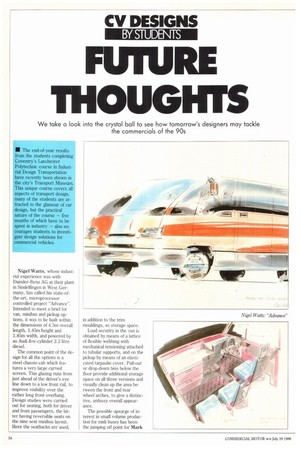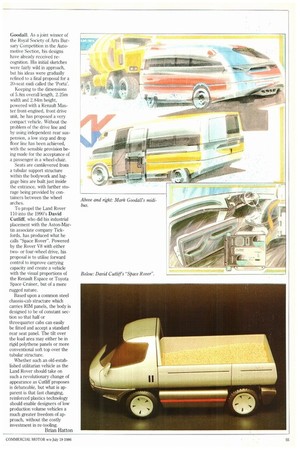FUTURE THOUGHTS
Page 56

Page 57

If you've noticed an error in this article please click here to report it so we can fix it.
We take a look into the crystal ball to see how tomorrow's designers may tackle the commercials of the 90s
Nigel Watts, whose industrial experience was with Daimler-Benz AG at their plant in Sindelfingen in West Germany, has called his state-ofthe-art, microprocessor controlled project "Advance". Intended to meet a brief for van, minibus and pickup options, it was to be built within the dimensions of 4.5m overall length, 1.85m height and 1.85m width, and powered by an Audi five-cylinder 2.2 litre diesel.
The common point of the design for all the options is a steel chassis-cab which features a very large curved screen. This glazing runs from just ahead of the driver's eye line down to a low front rail, to improve visibility over the rather long front overhang. Design studies were carried out for seating, both for driver and front passengers, the latter having reversible seats on the nine seat minibus layout. Here the seatbacks are used, in addition to the trim mouldings, as storage space.
Load security in the van is obtained by means of a lattice of flexible webbing with mechanical tensioning attached to tubular supports, and on the pickup by means of an elasticated tarpaulin cover. Pull-out or drop-down bins below the floor provide additional storage space on all three versions and visually clean up the area between the front and rear wheel arches, to give a distinctive, unfussy overall appearance.
The possible upsurge of interest in small volume production for midi buses has been the jumping off point for Mark Goodall. As a joint winner of the Royal Society of Arts Bursary Competition in the Automotive Section, his designs have already received recognition. His initial sketches were fairly wild in approach, but his ideas were gradually refined to a final proposal for a 20-seat midi called the 'Porta'.
Keeping to the dimensions of 5.8m overall length, 2.25m width and 2.84m height, powered with a Renault Master front-engined, front drive unit, he has proposed a very compact vehicle. Without the problem of the drive line and by using independent rear suspension, a low step and drop floor line has been achieved, with the sensible provision being made for the acceptance of a passenger in a wheel-chair.
Seats are cantilevered from a tubular support structure within the bodywork and luggage bins are built just inside the entrance, with further storage being provided by containers between the wheel arches.
To propel the Land Rover 110 into the 1990's David Cutliff, who did his industrial placement with the Aston-Martin associate company Tickfords, has produced what he calls "Space Rover". Powered by the Rover V8 with either twoor four-wheel drive, his proposal is to utilise forward control to improve carrying capacity and create a vehicle with the visual proportions of the Renault Espace or Toyota Space Cruiser, but of a more rugged nature.
Based upon a common steel chassis-cab structure which carries RIM panels, the body is designed to be of constant section so that half or threequarter cabs can easily be fitted and accept a standard rear seat panel. The tilt over the load area may either be in rigid polythene panels or more conventional soft top over the tubular structure.
Whether such an old-established utilitarian vehicle as the Land Rover should take on such a revolutionary change of appearance as Cutliff proposes is debateable, but what is apparent is that fast changing, reinforced plastics technology should enable designers of low production volume vehicles a much greater freedom of approach, without the costly investment in re-tooling.
Brian Hatton




























































































